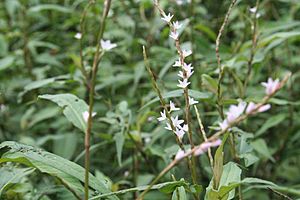Pygmy smartweed facts for kids
Quick facts for kids Pygmy smartweed |
|
|---|---|
 |
|
| Scientific classification | |
| Genus: |
Persicaria
|
| Species: |
minor
|
| Synonyms | |
|
Polygonum minus Huds. |
|
Pygmy Smartweed, also known as Persicaria minor, is a small plant that belongs to the Polygonaceae family. People also call it small water pepper or swamp willow weed. This herb originally comes from Asia. However, you can now find it growing in many parts of Europe and Australia too. It's quite popular in Southeast Asian cooking.
Contents
What is Pygmy Smartweed?
Pygmy Smartweed is a plant that loves wet places. It grows naturally in Southeast Asia, in countries like Malaysia, Thailand, Vietnam, and Indonesia. You can find it growing wild in cool, high areas. It also thrives in low, wet spots near rivers, ditches, and canals.
How Does Pygmy Smartweed Look?
This plant is a creeping type, meaning it spreads along the ground. Its stems are thin and can grow upright to about 1 to 1.5 meters tall. The stems are green with a bit of red. They are round and have short sections, called nodes, about 9 millimeters apart.
The leaves of Pygmy Smartweed are long and get narrower towards the end. They grow in an alternating pattern along the stem. They are green and have short, reddish stems called petioles. The flowers are tiny and light purple. They grow in clusters that can be 12 to 15 centimeters long.
How Do People Use Pygmy Smartweed?
Pygmy Smartweed is an edible herb, which means you can eat it! It's used in many ways, especially in cooking and traditional medicine.
Pygmy Smartweed in the Kitchen
In Malaysia and Singapore, this herb is often called "kesum." People eat the young shoots and leaves raw in salads, known as ulam. It's also used to add a special flavor to spicy dishes. You might find it in popular meals like laksa, nasi kerabu, asam pedas, and tom yam. Sometimes, its leaves are even used to make tea.
Pygmy Smartweed in Traditional Medicine
For a long time, Pygmy Smartweed has been part of traditional medicine in Malaysia. It was used to help new mothers recover after childbirth. It was also given to help with digestion problems.
Modern Studies on Pygmy Smartweed
Scientists have studied Pygmy Smartweed to understand its health benefits. They found that it has properties that can:
- Fight damage: It has antioxidants that protect your body's cells.
- Reduce swelling: It can help with inflammation.
- Fight germs: It has anti-microbial qualities.
- Help digestion: It can improve how your stomach works and prevent ulcers.
- Boost brain power: Some studies suggest it might help with memory and thinking.
- Prevent food spoilage: It can stop microbes from spoiling food.
Researchers have compared Pygmy Smartweed with other Malaysian herbs like Cosmos caudatus, Piper sarmentosum, Centella asiatica, and Syzygium polyanthum. Pygmy Smartweed had the most phenols (a type of healthy compound) and the strongest antioxidant power. Because of its helpful compounds, it has even been used to make special packaging film for food. This film helps keep food fresh!

